sensor AUDI R8 SPYDER 2011 Owner's Manual
[x] Cancel search | Manufacturer: AUDI, Model Year: 2011, Model line: R8 SPYDER, Model: AUDI R8 SPYDER 2011Pages: 244, PDF Size: 59.74 MB
Page 130 of 244
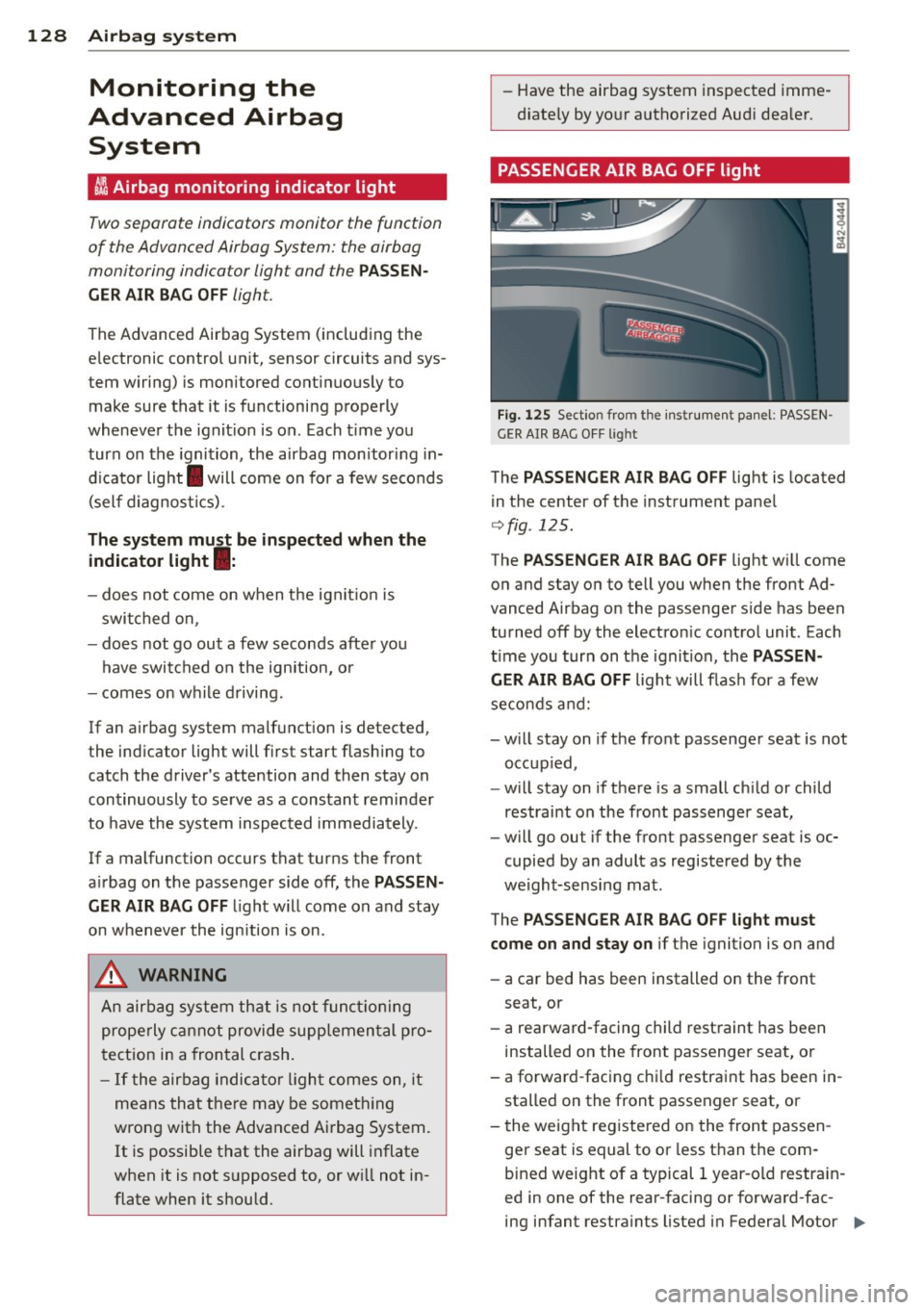
128 Airbag system
Monitoring the
Advanced Airbag
System
I Airbag monitoring indicator light
Two separate indicators monitor the function
of the Advanced Airbag System: the airbag
monitoring indicator light and the
PASSEN
GER AIR BAG
OFF light.
The Advanced Airbag System (includ ing the
electronic control unit, sensor circuits and sys
tem wiring) is monitored continuously to
make sure that it is functioning properly
whenever the ignit ion is on. Each time you
turn on the ignition, the airbag monitoring in
dicator light
I will come on for a few seconds
(self diagnostics) .
The system must be inspected when the
indicator light
I :
- does not come on when the ignit ion is
switched on,
- does not go out a few seconds after you
have switched on the ignition, or
- comes on while driving.
If an airbag system malfunction is detected,
the indicator light will first start flashing to
catch the driver's attention and then stay on
continuously to serve as a constant reminder
to have the system inspected immediately.
If a malfunction occurs that turns the front
a ir bag on the passenger side off, the
PASSEN
GER AIR BAG
OFF light will come on and stay
on whenever the ignition is on.
_& WARNING
An airbag system that is not funct ioning
properly cannot provide supplemental pro
tection in a frontal crash.
-If the airbag indicator light comes on, it
means that there may be something
wrong with the Advanced Airbag System.
It is possible that the airbag will inflate
when it is not supposed to, or will not in
flate when it should.
-
- Have the airbag system inspected imme
diately by your authorized Audi dea ler.
PASSENGER AIR BAG OFF light
Fig. 125 Sect ion from the instrument panel: PASSEN
GER AIR BAG O FF light
The PASSENGER AIR BAG OFF light is located
in the center of the instrument panel
<=> fig . 125.
The
PASSENGER AIR BAG OFF light will come
on and stay on to tell you when the front Ad
vanced Airbag on the passenger s ide has been
turned off by the electron ic control unit. Each
t ime you turn on the ignition, the
PASSEN
GER AIR BAG
OFF light will flash for a few
seconds and:
- w ill stay on if the front passenger seat is not
occupied,
- will stay on if there is a small child or child
restraint on the front passenger seat,
- will go out if the front passenger seat is oc
cupied by an adult as registered by the
weight-sensing mat.
The
PASSENGER AIR BAG OFF light must
come on and stay on
if the ignition is on and
- a car bed has been installed on the front
seat, or
- a rearward-facing child restraint has been
installed on the front passenger seat, or
- a forward-facing chi ld restraint has been in
stalled on the front passenger seat, or
- the weight reg istered on the front passen
ger seat is equal to or less than the com
bined weight of a typical 1 year-o ld restrain
ed in one of the rear-facing or forward-fac-
ing infant restraints listed in Federal Motor ..,.
Page 131 of 244
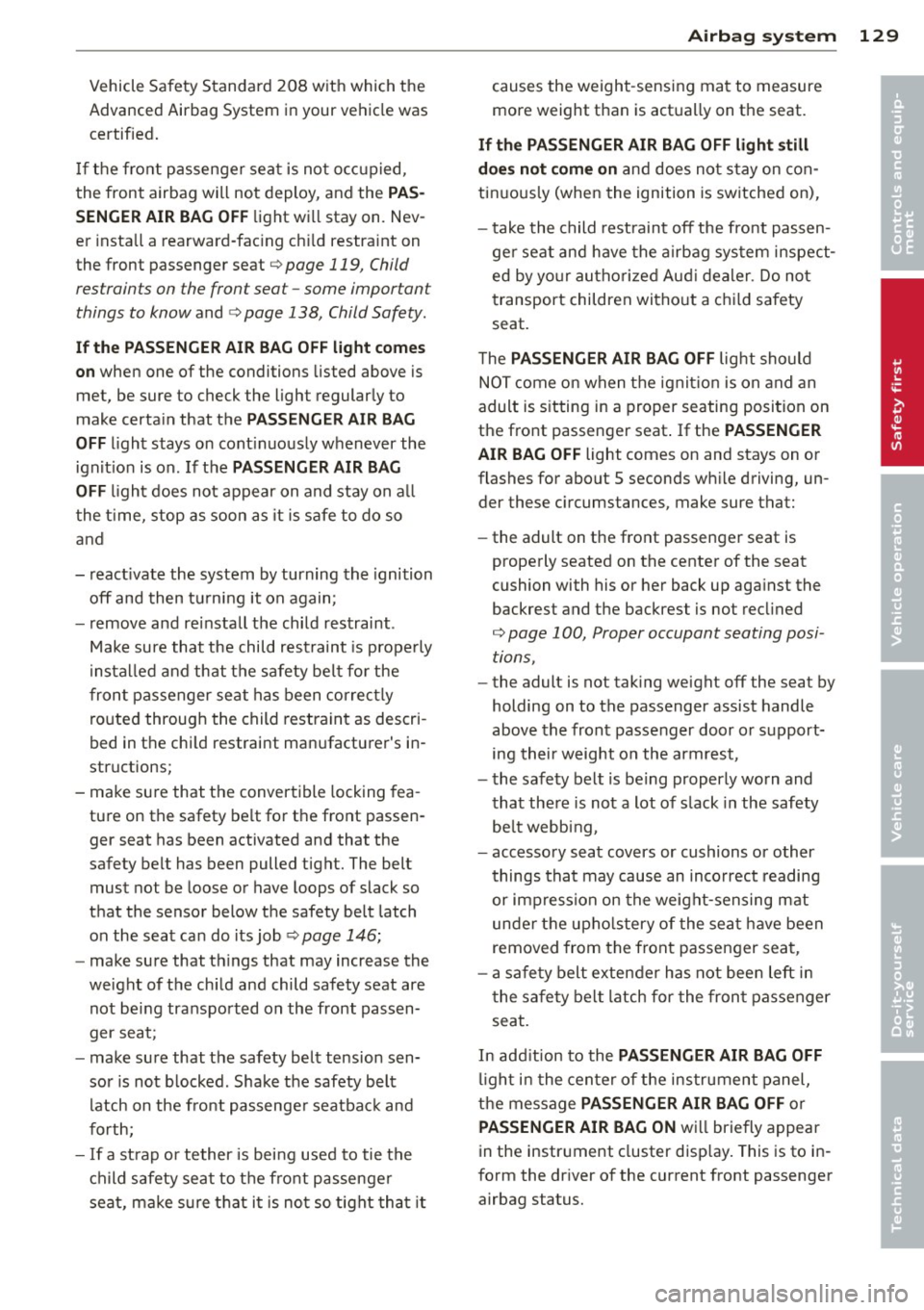
Vehicle Safety Standard 208 with which the
Advanced Airbag System in your vehicle was
certified.
I f the front passenger seat is not occ upied,
the front airbag will not deploy, and the
PA S
SENGER A IR BAG OF F
light will stay on. Nev
er insta ll a rearward-fac ing ch ild restra int on
the front passenger seat
c:> page 119, Child
restraints on the front seat -some important
things to know
and c:> page 138, Child Safety.
If the PASSENGER AIR BAG OFF light c om es
on
when one of the conditions listed above is
met, be sure to check the light regularly to
make certa in that the
PA SS ENG ER AIR BAG
OFF
light stays on cont inuously whenever the
ign it ion is on. If the
PA SSENGER AIR BA G
OFF
l ight does not appear on and stay on a ll
the t ime, stop as soon as it is safe to do so
and
- react ivate the system by turning the ignition
off and then tu rning it on again;
- remove and reinstall the chi ld restraint .
Make sure that the child restraint is properly
insta lled and that the safety be lt fo r the
front passenger seat has been correct ly
ro uted through the child restraint as descri
bed in the chi ld restraint man ufacturer's in
structions;
- make su re that the convertible locking fea
ture on the safety be lt for the front passen
ger seat has been activated and that the
safety belt has been pulled tight. The belt must not be loose or have loops of slack so
t h at the sensor below the safety belt latch
on the seat can do its job
c:> page 146;
- make sure that th ings that may increase the
weight of the ch ild and child safety seat are
not being transported on the front passen
ger seat;
- make sure that the safety belt tension sen
sor is not b locked. Shake the safety belt
latch on the front passenge r seatbac k and
forth;
- If a st rap or tether is being used to tie the
c hild safety seat to t he fro nt passenger
seat, make s ure t hat i t is no t so tight that it
A irbag system 129
causes the weight -sensing mat to measure
more weight than is act ually on the seat.
If th e PASSENGER AIR BAG OFF li ght s till
d oes not come on
and does not stay on con
tin uous ly (when the ignition is switched on),
- take the child rest ra int off the front passen-
ge r seat and have the a irb ag sys tem inspect
ed by yo ur authorized Aud i dealer. Do not
transport children witho ut a c hil d safety
seat.
T he
PASSENGER AIR BAG OFF lig ht sho uld
NOT come on when the ignit ion is on and an
adult is s itting in a proper seating position on
the front passenger seat . If the
PASSENGER
AIR BAG OFF
light comes on and stays on or
flashes for about 5 seconds wh ile driving, un
der these c ircumstances, make sure that:
- the adult on the front passenger seat is
properly seated on the center of the seat
cushion with his or her back up aga inst the
backrest and the backrest is not recl ined
c:> page 100, Proper occupant seating posi
tions,
- the adult is not tak ing weight off the seat by
holding on to the passenger assist handle
above the front passenger door or support
ing their weight on the armrest,
- the safety belt is be ing properly worn and
that there is not a lot of s lack in the safety
be lt webbing,
- accesso ry seat covers or cushions or other
things that may cause an inco rrect reading
or impression on the weight-sensing mat
under t he upho ls tery of the sea t have been
removed from the front passenger sea t,
- a safety belt extender has not been left in
the sa fe ty belt latch for the fron t passenger
seat.
In add ition to the
PASSENGER AIR BAG OFF
l igh t in the center of the instrument panel,
the message
PASSENGER AIR BAG OFF or
PASSENGER AIR BAG ON w ill briefly appear
i n the instrument cluster disp lay. This is to in
form the dr iver of the current front passenger
airbag status.
•
•
Page 134 of 244

132 Airbag system
Other things that can affect Advanced
Airbag performance
Changing the vehicle's suspension system can
change the way that the Advanced Airbag Sys
tem performs in a crash. For example, using
tire-r im combinations not approved by Aud i,
lowering the vehicle, changing the stiffness of
the suspension, including the sp rings, suspen
sion struts, shock absorbe rs etc. can change
the forces that are measured by the a irbag
sensors a nd sent to the electron ic control
un it. Some suspension changes ca n, for exam
p le, increase the force levels measured by the
sensors and make the airbag system deploy in
crashes in which it would not dep loy if the
changes had not been made . Other kinds of
changes may reduce the force levels meas ured by the sensors and prevent the airbag
from deploying when it should .
The sensors in the safety belt buckle for the driver and front passenger seat tell the elec
tronic con trol module if the safety bel t is
latched or not .
If the safety belt is being used,
the front a irbag will deploy at a slightly high
e r rate of vehicle deceleration than if the safe
ty belt i s not being used. Therefo re, i n a par
ticular co llision, it is poss ible that an a irbag
will not deploy at a seati ng position where the
safety be lt is being used but will inflate at the
position where the safety belt is not being
used. It is important that nothing interfere
with the safety belt buckles so that the sen
sors can send the correct information about
safety belt use to the electron ic control unit .
A WARNING
Changing the vehicle 's s uspension includ
ing use of unapproved tire-rim combina
t ions can change Advan ced Airbag per
formance and increase the risk of ser io us
personal in jury in a crash.
- Never install suspens io n components
that do not have the same performance
characteristics as the components origi
nally installed on your vehicle .
- Never use tire -rim combinat ions that
have not been approved by Audi.
A WARNING
-Items stored between the safety be lt
buckle and the center console can cause
the sensors in the buckle to send the
wrong information to the e lectronic con
trol module and prevent the Advanced Air
bag System from wo rking properly.
- Always ma ke sure that nothing can inter
fere wi th the safety belt buckles a nd that
they are not obstruc ted .
@ For the sake of the env ironment
Undeployed airbag modules and preten
s ione rs might be classified as Perchlorate
Ma teria l - specia l hand ling may apply, see
www .d tsc.ca.gov/hazardouswaste/per
ch lorate. W hen the vehicle or parts of t he
restraint system including airbag modu les
and safety belts with pretensioners are
scrapped, all applicab le laws and regu la
tions must be observed. Your authorized
Audi dealer is familia r with these require
ments and we recommend that you have
your dealer perform this service fo r you.
Knee airbags
Description of knee airbags
The airbag system can provide supplemental
protection to properly restrained front seat occupants .
Fig. 1 26 D river 's ai rb ag
The airbag for the driver is Located in the in
strument panel underneath the steering
whee l
c::> fig. 126, the airbag for the passenger
is at about the same height in the inst rument
panel underneath the g love compartment . ..,_
Page 137 of 244
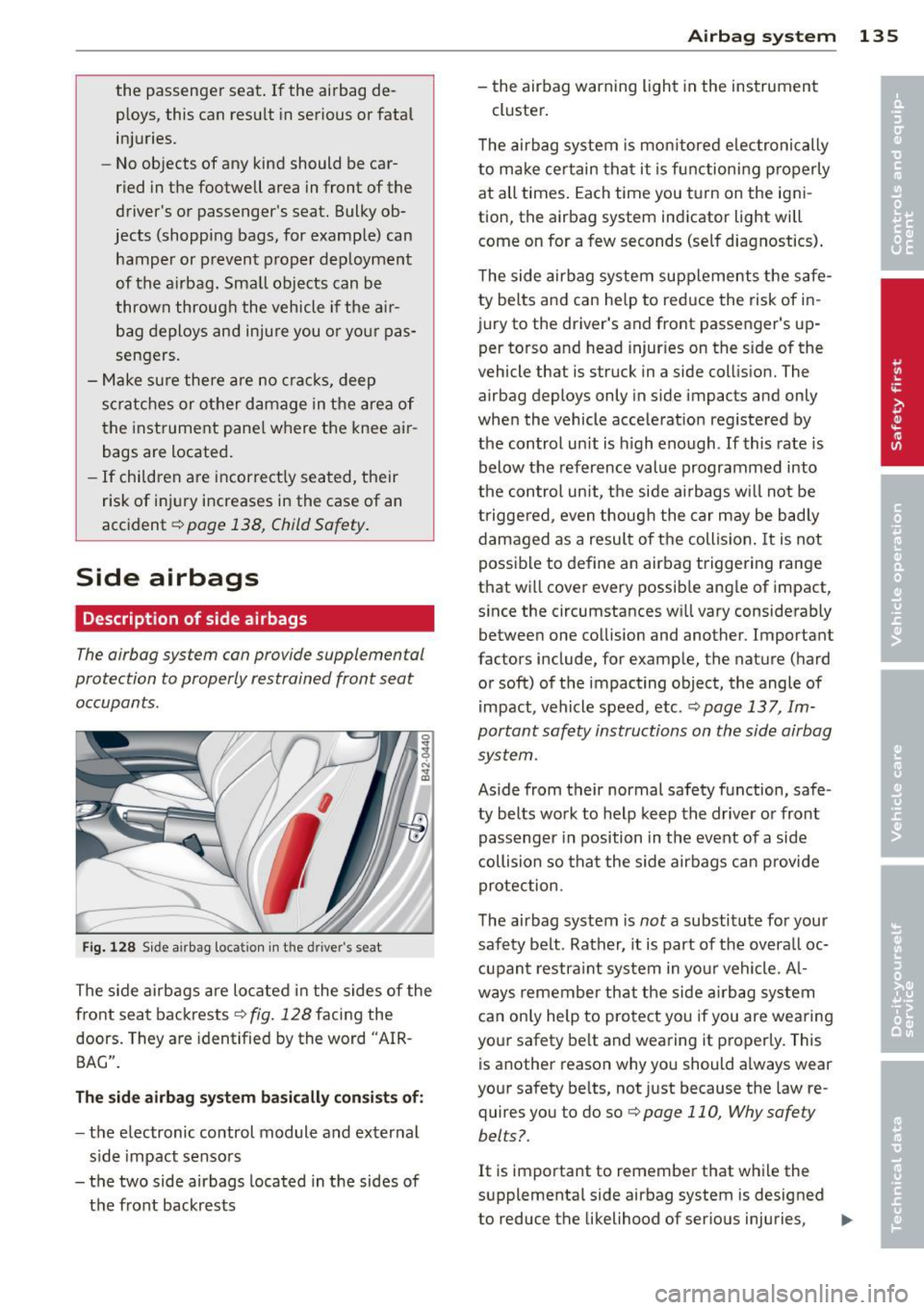
the passenger seat. If the airbag de
ploys, this can resu lt in serious or fatal
injuries.
- No objects of any kind should be car
ried in the footwell area in front of the
driver's or passenger's seat. Bulky ob
jects (shopping bags, for example) can hamper or prevent proper deployment
of the airbag. Small objects can be
thrown through the vehicle if the ai r
bag deploys and injure you or your pas
sengers.
- Make sure there are no cracks, deep
scratches or other damage in the area of
the instrument pane l where the knee air
bags are located.
- If children are incorrect ly seated, their
risk of injury increases in the case of an
accident ¢
page 138, Child Safety.
Side airbags
Description of side airbags
The airbag system can provide supplemental
protection to properly restrained front seat occupants.
F ig . 128 Side a irbag location in t he d river 's seat
The s ide airbags are located in the sides of the
front seat backrests
r::} fig . 128 facing the
doors. They are identified by the word "AIR
BAG".
The side airbag system basically consists of:
-the electronic control module and external
side impact sensors
- the two side airbags located in the sides of
the front backrests
Airbag system 135
- the airbag warning light in the instrument
cluster.
The airbag system is mon itored electronically
to make certain that it is functioning p roperly
at all times. Each time you turn on the igni
tion, the airbag system indicator light will
come on for a few seconds (self diagnostics) .
The side airbag system supplements the safe
ty belts and can help to reduce the risk of in
jury to the driver's and front passenger 's up
per torso and head injuries on the side of the
vehicle that is struck in a side collision. The
airbag deploys only in side impacts and only
when the vehicle acceleration registered by
the control unit is high enough .
If this rate is
below the reference value programmed into
the control unit, the side airbags will not be
triggered , even though the car may be badly
damaged as a result of the collision. It is not
possible to define an airbag triggering range
that will cover every possible angle of impact,
since the circumstances will vary considerably between one collision and another. Important
factors include, for example, the nature (hard
or soft) of the impacting object, the angle of
impact, vehicle speed, etc.
¢page 137, Im
portant safety instructions on the side airbag
system .
Aside from their normal safety function, safe
ty belts work to help keep the driver or front
passenger in position in the event of a side
collision so that the side airbags can provide
protection.
The airbag system is
not a substitute for your
safety belt . Rather, it is part of the overall oc
cupan t restra int system in your vehicle. Al
ways remember that the side airbag system
can only help to protect you if you are wearing
your safety be lt and wearing it properly. This
is another reason why you should always wear
your safety be lts, not just because the law re
quires you to do so¢
page 110, Why safety
belts? .
It is important to remember that while the
supplemental side airbag system is designed
to reduce the likelihood of serious injuries,
IIJ>,
Page 138 of 244

136 Airbag system
o ther injuries, for example, swelling, bruising,
and minor abrasions can also be associated
with deployed side airbags. Remember too,
side airbags wi ll deploy only once and on ly in
certain kinds of accidents - your safety belts
are a lways there to offer protect ion .
Vehicle damage, repa ir costs or even the lack
of vehicle damage are not necessarily an indi
cation of over-sensitive or failed airbag activa
tion . In some co llisions, both front and side
a irbags may inflate. Remember too, that air
bags will dep loy only once and only in certain
kinds of collisions -your safety be lts a re al
ways there to offer protec tion in those acci
dents in wh ic h ai rbags are not supposed to
deploy or when they have already deployed .
The side airbag system will not deploy:
- when the ignition is turned off
- in s ide collisions when the acceleration
measured by the sensor is too low
- in front-end collisions
- in rear-end collisions
- in rollovers.
I n some types of acc idents the front a irbags
and side a irbags may be triggered together.
A WARNING
- Safety belts and t he ai rbag system will
only provide protection when occ upants
are in the proper seating posit ion
¢page 137.
-If the airbag indicator light comes on
when the veh icle is being used, have the
system inspected immediately by your
authorized Audi dealer. The a irbag may
not work p roperly when the vehicl e ac
celeration in a side co llision is h igh
enough to activa te the airbag.
-
How supplemental side airbags work
Side airbags deploy instantly and can help re
duce the risk of upper torso injuries for occu
pants who are properly restrained.
F ig . 1 29 Inflated s ide a irbags on left s ide of veh icle
When the system is triggered, the airbag is
filled with propellant gas and b reaks through
a seam in the seat surface area ma rked "AIR
BAG".
It expands between the side trim panel
and the passenger. In order to help provide
t hi s additional protection, the side airbag
must inflate w ithin a fraction of a second at
very h igh speed and with great force . The sup
pleme nta l side airbag could injure you if your
seat ing pos it ion is not proper or upright or if
items are loca ted in the area where the s up
pleme nta l side airbag expands. This applies
especially to children ¢
page 138, Child Safe
ty .
Supplemental side airbags inflate between
the occ upant and the door panel on the side
of the vehicle that is struck in certain side col
lis ion ¢
fig. 129.
Although they are not a soft pi llow, they can
"cushion" the impact and in this way they can
help to reduce the risk of injury to the upper
part of the body.
A fine dust may deve lop when the airbag de
ploys. This is normal and does not mean there
is a fire in the vehicle.
Page 141 of 244
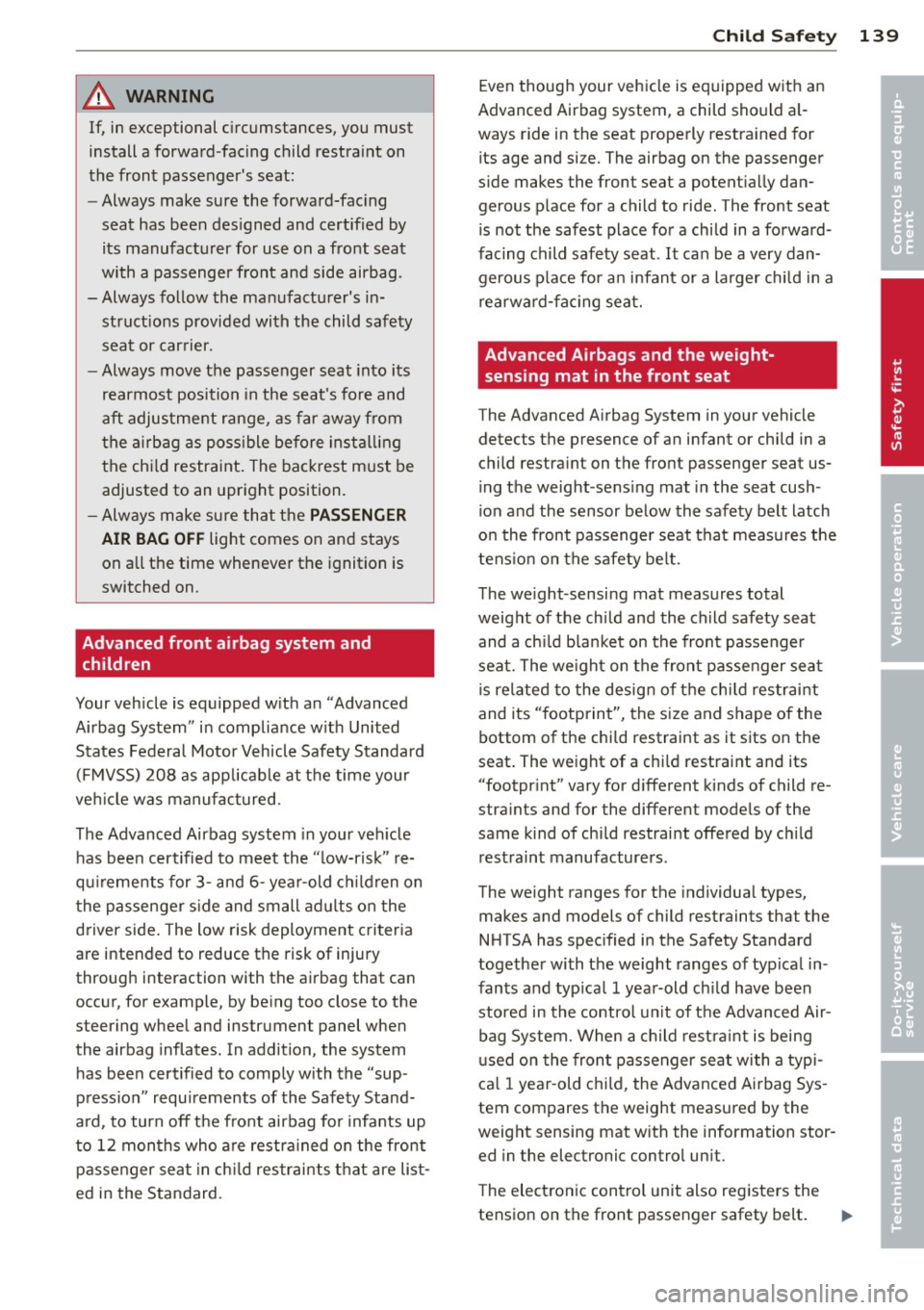
A WARNING ,~
If, in exceptional circumstances, you must
install a forward-facing child restraint on
the front passenger's seat:
- Always make sure the forward-facing
seat has been designed and certified by
its manufacturer for use on a front seat
with a passenger front and side airbag.
-Always follow the manufacturer's in
structions provided with the child safety
seat or carrier.
- Always move the passenger seat into its
rearmost position in the seat's fore and
aft adjustment range, as far away from
the airbag as possible before installing
the child restraint. The backrest must be
adjusted to an upright position.
- Always make sure that the
PASSENGER
AIR BAG OFF light comes on and stays
on all the time whenever the ignition is
switched on.
Advanced front airbag system and children
Your vehicle is equipped with an "Advanced
Airbag System" in compliance with United
States Federal Motor Vehicle Safety Standard
(FMVSS) 208 as applicable at the time your
vehicle was manufactured.
The Advanced Airbag system in your vehicle
has been certified to meet the "low-risk" re
quirements for 3- and 6- year-old children on
the passenger side and small adults on the
driver side. The low risk deployment criteria
are intended to reduce the risk of injury
through interaction with the airbag that can
occur, for example, by being too close to the
steering wheel and instrument panel when
the airbag inflates. In addition, the system has been certified to comply with the "sup
pression" requirements of the Safety Stand
ard, to turn
off the front airbag for infants up
to 12 months who are restrained on the front
passenger seat in child restraints that are list
ed in the Standard.
Child Safety 139
Even though your vehicle is equipped with an
Advanced Airbag system, a child should al
ways ride in the seat properly restrained for
its age and si ze. The airbag on the passenger
side makes the front seat a potentially dan
gerous place for a child to ride . The front seat
is not the safest place for a child in a forward
facing child safety seat . It can be a very dan
gerous place for an infant or a larger child in a
rearward-facing seat.
Advanced Airbags and the weight
sensing mat in the front seat
The Advanced Airbag System in your vehicle detects the presence of an infant or child in a
child restraint on the front passenger seat us
ing the weight -sensing mat in the seat cush
ion and the sensor below the safety belt latch
on the front passenger seat that measures the
tension on the safety belt.
The weight -sensing mat measures total
weight of the child and the child safety seat
and a child blanket on the front passenger
seat. The weight on the front passenger seat
is related to the design of the child restraint
and its "footprint", the size and shape of the
bottom of the child restraint as it sits on the
seat. The weight of a child restraint and its
"footprint" vary for different kinds of child re
straints and for the different models of the
same kind of child restraint offered by child
restraint manufacturers .
The weight ranges for the individual types,
makes and models of child restraints that the
NHTSA has specified in the Safety Standard
together with the weight ranges of typical in
fants and typical 1 year-old child have been
stored in the control unit of the Advanced Air
bag System. When a child restraint is being
used on the front passenger seat with a typi
cal 1 year-old child, the Advanced Airbag Sys
tem compares the weight measured by the
weight sensing mat with the information stor
ed in the electronic control unit.
The electronic control unit also registers the
tension on the front passenger safety belt. ..,. •
•
Page 142 of 244
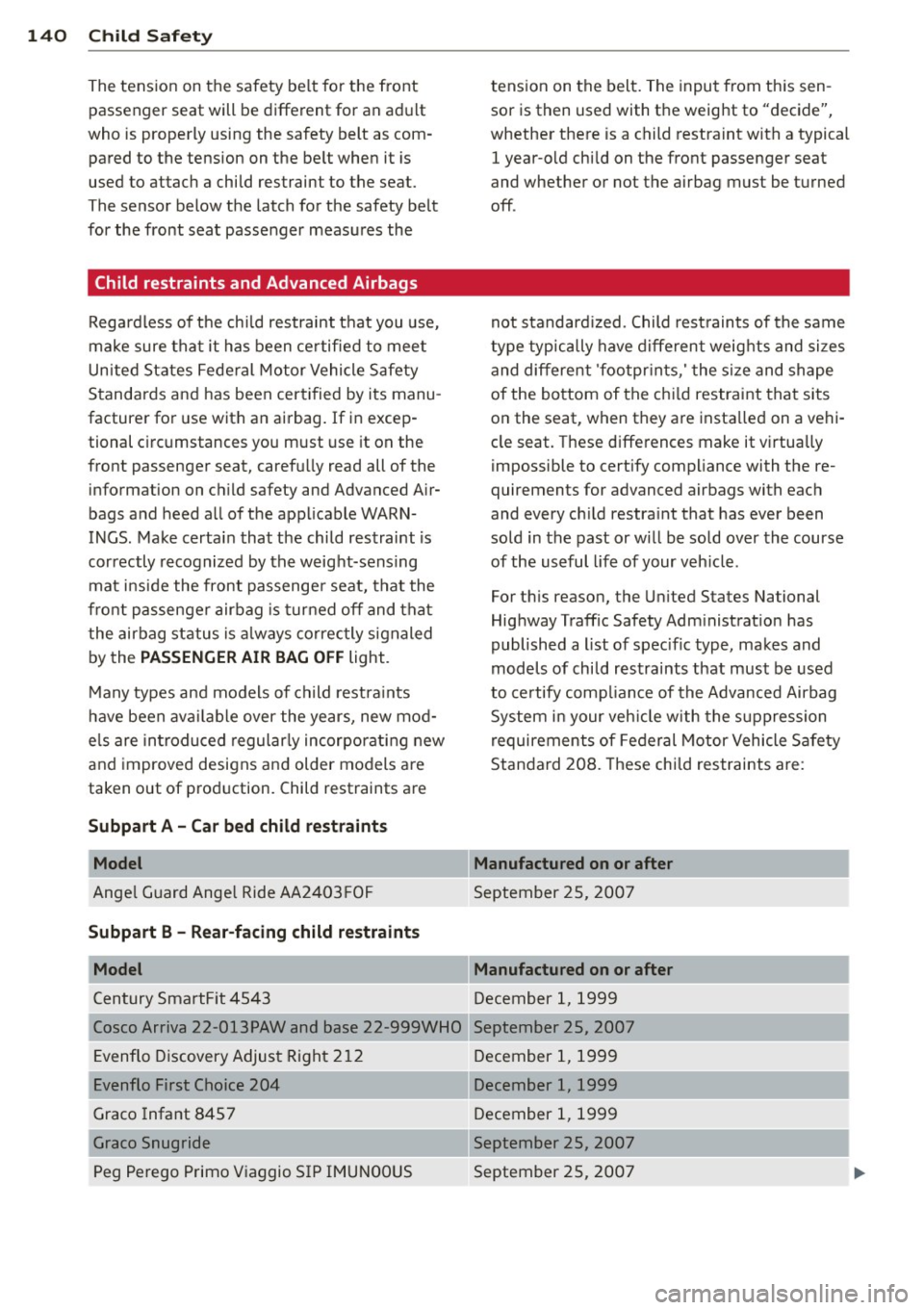
140 Child Safety
The tension on the safety belt for the front
passenger seat will be different for an adult
who is properly using the safety belt as com
pared to the tension on the be lt when it is
used to attach a child restraint to the seat.
The sensor below the latch for the safety belt
for the front seat passenger measures the
Child restraints and Advanced Airbags
Regardless of the ch ild restraint t hat you use,
make sure that it has been certified to meet
United States Fede ral Motor Vehicle Safety
Standards and has been certified by its manu
facturer for use with an airbag . If in excep
tional c ircumstances you must use it on the
front passenger seat, caref ully read all of the
information on c hild safety and Advanced A ir
bags and heed all of the applicable WARN
INGS . Make certain that the child restraint is
correctly recognized by the weight-sensing mat i nside the front passenge r seat, that the
fro nt passenger airbag is turned off and that
the airbag status is a lways correctly signaled
by the
PASSENGER AIR BAG O FF light.
M any types and models of child restra ints
have been ava ilable over the years, new mod
e ls are in troduced regularly incorporating new
and improved designs and older models are
taken out of prod uction. Child restraints are
Subpart A -Car bed child restraints
Model
Ange l Guard Ange l Ride AA2403 FOF
Subpart B -Rear-facing child restraints
Model
C en tury SmartFit 4543
Cosco Arriva 22-013PAW and base 22-999WHO
Evenflo D iscovery Adjust Right 2 12
Evenflo First Cho ice 204
Graco Infant 8457
Graco Snugride
Peg Perego Primo Viaggio SIP IMUN00US tension on the belt. The input from th
is sen
sor is then used with the weight to "decide",
whether there is a child restra int with a typical
1 year-old chi ld on the front passenger seat
and whether or not the airbag must be turned
off .
not standard ized . Child rest raints of the same
type typ ically have different weights and sizes
and different 'foo tpr ints,' the size and shape
of the bottom of the chi ld restra int tha t sits
on the seat, when they are insta lled on a vehi
cle seat. These diffe rences make it virtually
impossible to certify compliance with the re
quirements for advanced airbags with each
and every ch ild restra int that has ever been
sold in the past or will be sold over the course of the useful l ife of your veh icle .
For t his reason, the United States National
Highway Traffic Safety Adm inistrat ion has
published a list of spec ific type, makes and
models of chi ld restraints that must be used
to certify comp liance of the Advanced Airbag
System in your veh icle with the suppression
requirements of Federal Motor Vehicle Safety
Standard 208. These chi ld restraints are:
Manufactured on or after
September 25, 2007
Manufactured on or after
December 1, 1999
September 25, 2007 December 1, 1999
December 1, 1999
December 1, 1999
September 25, 2007
September 25, 2007
Page 157 of 244
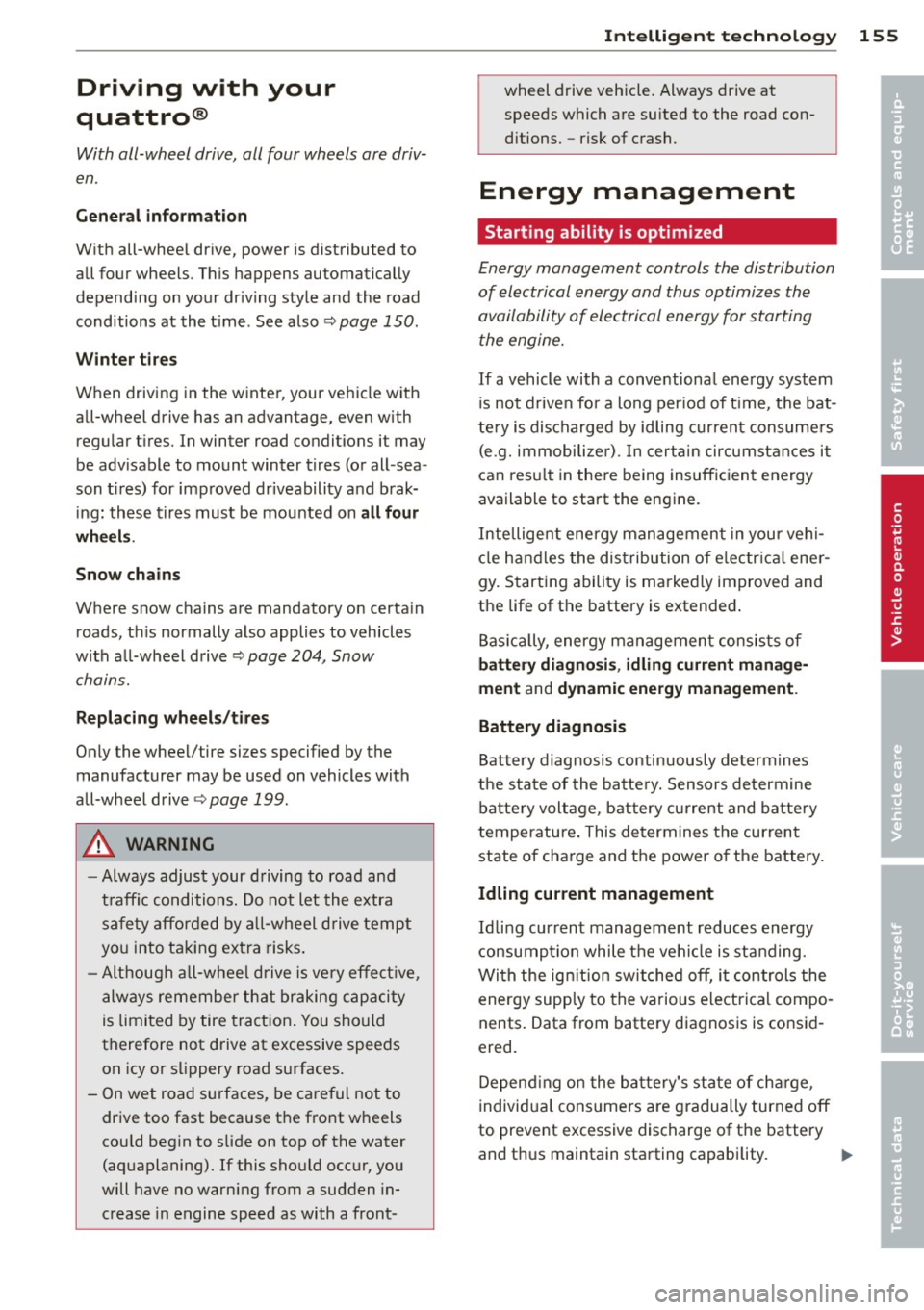
Driving with your
quattro ®
With all-wheel drive, all four wheels are driv
en .
General information
With all-wheel drive, power is distributed to
all four wheels . This happens automatically
depending on your driving style and the road
conditions at the time. See also
t::;> page 150.
Winter tires
When driving in the winter, your vehicle with
all-wheel drive has an advantage, even with regular tires. In winter road conditions it may
be advisable to mount winter tires (or all -sea
son t ires) for improved driveability and brak
ing: these tires must be mounted on
all four
wheels.
Snow chains
Where snow chains are mandatory on certain
roads, th is normally also applies to vehicles
with all-wheel drive
Q page 204 , Snow
chains.
Replacing wheels/tires
Only the wheel/tire sizes specified by the
manufacturer may be used on vehicles with
all-wheel drive
<=> page 199.
A WARNING
-Always adjust your driving to road and
traffic conditions. Do not let the extra
safety afforded by all-wheel drive tempt
you into taking extra risks.
- Although a ll-wheel drive is very effect ive,
always remember that braking capacity
is limited by tire traction. You should
therefore not drive at excessive speeds
on icy or slippery road surfaces.
- On wet road surfaces, be careful not to
drive too fast because the front wheels
cou ld beg in to slide on top of the water
(aquaplaning). If this should occur, you
will have no warning from a sudden in
crease in engine speed as with a front-
-
Intelligent technology 155
wheel drive vehicle. Always drive at
speeds which are su ited to the road con
ditions. -risk of crash.
Energy management
Starting ability is optimized
Energy management controls the distribution
of electrical energy and thus optimizes the
availability of electrical energy for starting the engine.
If a vehicle with a conventional energy system
is not driven for a long per iod of time, the bat
tery is discharged by idling current consumers
(e .g. immobi lizer). In certain circumstances it
can resu lt in the re being insufficient energy
available to start the engine.
Intelligent energy management in your vehi
cle handles the distribution of e lectr ical ener
gy. Starting ability is markedly improved and
the life of the battery is extended .
Basically, energy management consists of
battery diagnosis , idling current manage
ment
and dynamic energy management .
Battery diagnosis
Battery diagnosis continuously determines
the state of the battery. Sensors determine
battery voltage, battery current and battery
temperature . This determines the current
state of charge and the power of the battery.
Idling current management
Idling current management reduces energy
consumption while the vehicle is standing.
With the ign ition switched off, it controls the
energy supply to the various electrical compo
nents. Data from battery diagnosis is consid
ered.
Depending on the battery's state of charge,
individual cons umers are gradually turned off
to prevent excessive discharge of the battery
and thus maintain starting capability. .,..
•
•
Page 203 of 244
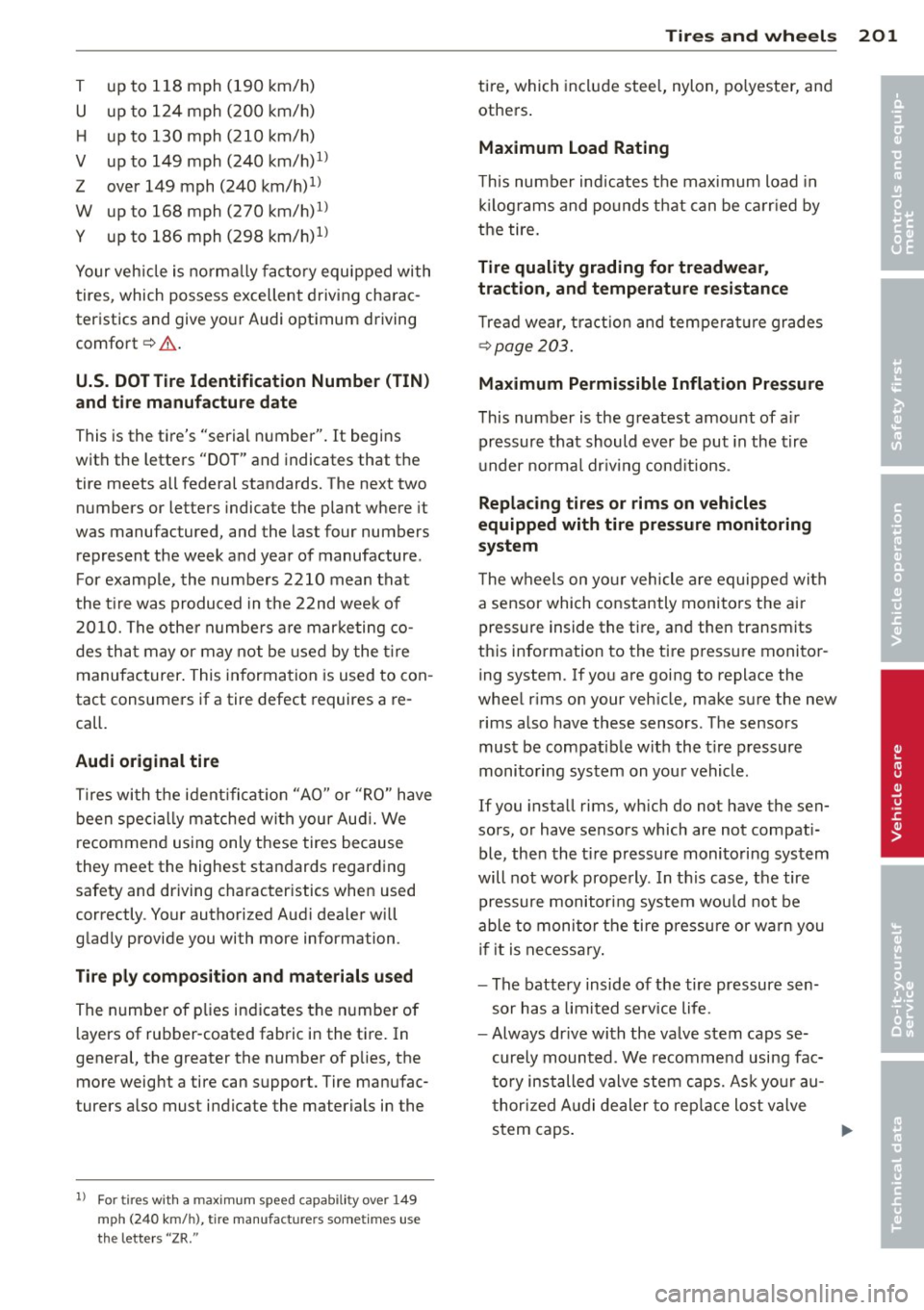
T up to 118 mph (190 km/h)
U up to 124 mph (200 km/ h)
H up to 130 mph (210 km/ h)
V up to 149 mph (240 km/h)
1 )
Z over 149 mph (240 km/h)1l
W up to 168 mph (270 km/h)
1
)
Y up to 186 mph (298 km/h)1
)
Your veh icle is no rma lly factory equipped with
tires , which possess excellent driving charac
teristics and give your Audi opt imum driving
comfort ¢&. .
U.S. DO T Tire Identification Numbe r (TIN )
a nd ti re manufa cture d ate
This is the tire's "serial number". It begins
with the letters "DOT" and indicates that the
ti re meets all federal standards. The next two
numbe rs or letter s indicate the plant where it
w as manufac tured, and the las t four numbers
represent the week and year of manufacture .
For example, the numbers 2210 mean that
the t ire was produced in the 22nd week of
20 10. The othe r numbe rs a re mar keting co
des tha t may or may not be used by the t ire
manufacturer . This information is used to con
tact consumers if a tire defect requires a re
call.
Audi original tire
Tires wi th the ident ificat io n "AO" or "RO" have
been spec ia lly matched with your Aud i. We
recommend using only these tires because
they meet the highest standards regarding
safety and driving character istics when used
correctly . Your authori zed Audi dealer will
glad ly provide you wi th more information .
Tire ply compo sit ion and materials u sed
The number of p lies ind icates the n umbe r of
l ayers of rubber-coat ed fabric in the t ire. In
general, the greater the number of p lies, the
more weig ht a tire can support. Tire manufac
turers also must indicate the ma terials in the
ll Fo r tires wit h a m ax im um s pee d cap abil ity over 149
mph (2 4 0 k m/h) , tire man ufacturers some times u se
th e le tters "Z R."
Tire s an d wheel s 201
tire, which incl ude stee l, nylon, po lyester, and
others .
Maximum Load Rating
This number indicates the maximum load in
kil ograms and pounds that can be ca rr ied by
the tire.
Tire quality grading for treadwear ,
traction, and temperature resistance
T read wear, t raction and tempera tu re grades
¢ page 203.
Maximum Permissible Inflation Pr essure
This number is the greatest amount of a ir
pressure that should ever be put in the tire
u nder norma l dr iv ing cond itions .
Replacing tires or rim s on veh icles
equipped with tire p ressure monitoring
system
T he wheels on yo ur vehicle are equippe d with
a sensor which constantly monitors the ai r
pressure inside the tire, a nd then transmits
th is information to th e tire press ure monitor ·
ing system. If you are going to replace the
whee l rims on your veh icle, make s ure the new
rims also have these sensors . The sensors
must be compatible with the t ire pressure
monito ring system on your vehicle .
If you install rims, wh ic h do not have the sen
sors, or have senso rs which are not compati
ble , then the t ire p ressure monitoring system
will not wor k prope rly. In t his cas e, the tire
pressure monitoring system wou ld not be
able to moni tor the tire pressure or warn you
i f i t is necessary .
- The battery inside of the tire pressure sen
sor has a limited se rvice life .
- Always dr ive with the valve stem caps se
curely mounted . We recommend using fac
t o ry installed valve stem caps. As k your au
t hor ized A udi dealer to rep lace lost valve
stem caps .
•
•
Page 204 of 244
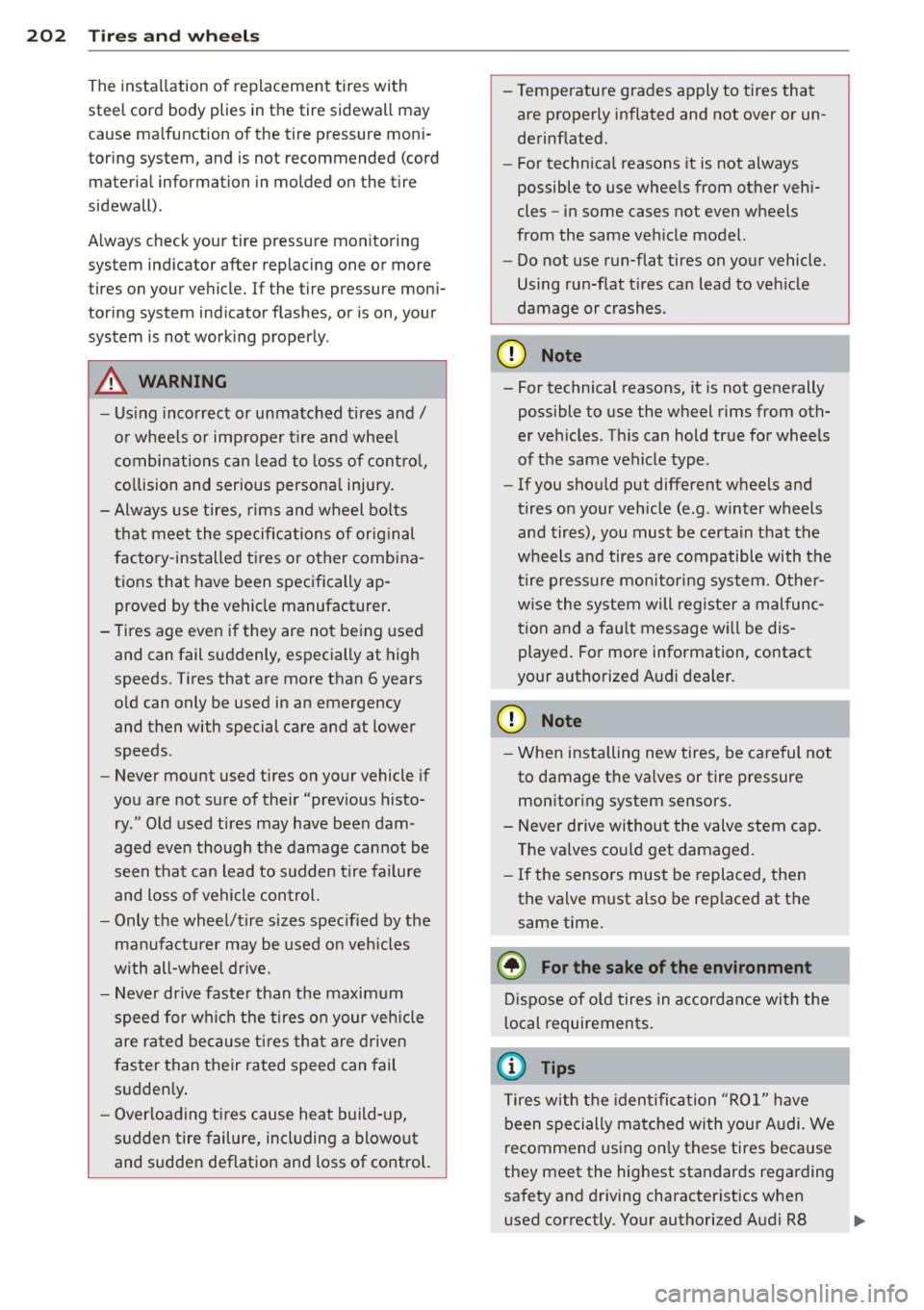
202 Tir es and whee ls
The installation of replacement tires with
steel cord body plies in the tire sidewall may
cause ma lfunction of the tire pressure moni
toring system, and is not recommended (cord material information in molded on the tire
sidewall) .
Always check your tire pressure monitoring
system indicator after replacing one or more
tires on your vehicle. If the tire pressure moni
toring system indicator flashes, or is on, your
system is not work ing properly.
A WARNING
- Us ing incorrect or unmatched tires and/
or wheels or improper t ire and whee l
combinations can lead to loss of contro l,
co llision and serious persona l injury.
- Always use tires, rims and wheel bo lts
that meet the specifications of orig inal
factory-installed t ires or other combina
tions that have been specifically ap
proved by the vehicle manufacturer .
- Tires age even if they are not being used and can fail su ddenly, especially at high
speeds. Tires that are more than 6 years
o ld can only be used in an emergency
and then with special care and at lower
speeds .
- Never mount used tires on your vehicle if
you a re not sure of their "previous histo ry." Old used tires may have been dam
aged even though the damage cannot be
seen that can lead to sudden tire failure
and loss of vehicle control.
- Only the wheel/tire s izes spec ified by the
manufactu rer may be used on veh icles
with all-wheel dr ive.
- Never drive faste r than the maxim um
speed for which the tires on your veh icle
are ra ted because tires that are driven
f aster than their rated speed can fail
sudden ly .
- Overloading ti res cause heat build-up,
sudden tire failure, incl uding a blowout
and sudden deflation and loss of control. -
Temperature grades apply to tires that
are properly inflated and not over or un
derinflated.
- For technical reasons it is not always
possible to use wheels from other vehi
cles -in some cases not even wheels
from the same veh icle model.
- Do not use run-flat tires on your vehicle.
Using run-flat t ires can lead to veh icle
damage or crashes .
@ Note
- For technical reasons, it is not generally
possible to use the wheel rims from oth
er veh icles . Th is can hold true for wheels
of the same vehicle type .
- If you should put different wheels and
tires on your veh icle (e.g . winter wheels
and tires), you must be certain that the
wheels and tires are compatible with the tire pressure monitoring system. Other
w ise the system will register a malfunc
tion and a fau lt message w ill be dis
played. For more information, contact
your authorized Audi dealer.
(D Note
- When installing new tires, be care ful not
to damage the va lves or tire pressure
monitoring system sensors.
- Never drive without the valve stem cap.
The va lves cou ld get damaged.
- If the sensors must be replaced, then
the valve must also be replaced at the
same time .
@ For the sake of the environment
Dispose of o ld tires in accordance with the
l ocal requirements .
@ Tips
Tires with the iden tificatio n "RO l" have
been specially matched with your A udi. We
r ecommend using on ly these tires because
they meet the highest standards regarding
safety and driving characteristics when used correctly . Your authorized Audi R8